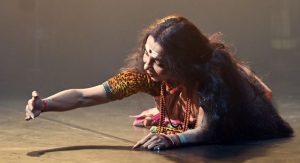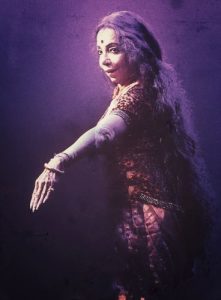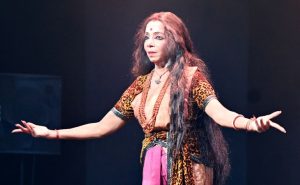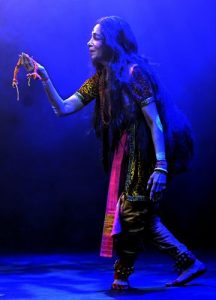The Rebel, The Rasa: Exploring Akka Mahadevi

An eminent Bharatanatyam exponent, choreographer, teacher, and curator whose contributions to Indian classical dance span decades is the charming Kalashri Dr. Lata Surendra. Known for her deep scholarship and spiritual approach to dance, she brings rare depth and intensity to every performance. Her productions often transcend the stage, becoming profound experiences that blend tradition with innovation. She is a recipient of the prestigious Kalashree award and is widely respected for mentoring a generation of committed dancers. With every performance, Dr. Lata Surendra continues to redefine Bharatanatyam as a powerful medium for storytelling, introspection, and transformation. Excerpts from her recent interview:
Your recent production “Diksha of a Mystic Rebel – Akka Mahadevi” at the NCPA’s Experimental Theatre moved the audience to tears. What inspired you to bring Akka Mahadevi to the stage?
Akka Mahadevi is not just a saint or a poet—she’s a force. A spiritual storm. What inspired me was her fearless individuality, her complete surrender to the formless divine, and her inner fire that refused to conform. In an age where women were silenced, she roared. That voice—through her vachanas—still echoes today. I felt compelled to dance that echo.
How did you navigate such a unconventional and deeply philosophical, through Bharatanatyam?
It was a challenge, but also a blessing. Bharatanatyam, with its grammar of abhinaya and its sacred origins, lends itself beautifully to deep introspection and spiritual narrative. I had to go beyond the form’s decorative aspects and arrive at a space of surrender—like Akka herself. I let her poetry guide me. I wove her vachanas into the existing framework of the classical Varnam—combining intense jathis and rhythm with moments of stillness, silence, and spiritual tumult.
The depiction of her tearing away her clothes and societal bindings was powerful. How did you approach that delicate moment on stage?
That moment was not about nudity. It was about renunciation. About discarding every worldly identification to be in union with the One. I portrayed it through movement that stripped away layers—not clothes—but ego, identity, fear, and illusion. Her act was one of profound devotion and rebellion. I tried to capture the pain and liberation of that moment—the tearing was symbolic, a release into spiritual purity.
The Shivalinga creation sequence at the start was strikingly different. Can you tell us more about that?
That was a choreographic choice born out of the need to portray the nirguna-nirakara—the formless, attribute-less divine. I didn’t want to begin with a ritualistic linga; instead, we sculpted it in space—using movement, light, and rhythm. From the elemental to the eternal. The idea was to draw the intangible into tangible reality—just as Akka did in her communion with Chennamallikarjuna.
You performed with your disciples, how important is collaboration in productions like these?
Oh, very important. I collaborated with Ananya Iyer, Megha Pillai, and Lavanya Uchil, I always say, dance is a shared prayer. My disciples are not just performers—they’re seekers. We rehearsed not just movement, but intent. They understood Akka’s pain, her longing, her courage. Their role wasn’t to support me but to hold the space with me—to become the forest, the wind, the divine presence around Akka. They became the metaphors she lived by.
The vachanas used were incredibly resonant. How did you choose which ones to choreograph?
Akka’s vachanas are spontaneous outpourings of divine love. Every vachana is a universe. I chose those that mirrored her journey—from realization to renunciation, from despair to union. For instance, when she says “You are the forest, my Beloved…” it’s not just poetry, it’s a cosmic embrace. I matched the vachanas with sections of the varnam and improvised where needed, to let her voice speak through the body.
Many in the audience were visibly moved by the finale. Could you describe your experience of that moment on stage?
I think I ceased to be Lata Surendra in that moment. When Akka surrenders completely—beating at her body, questioning, yearning, and finally dissolving—it’s like light merging with light. There’s a stillness that comes, and the dance dances itself. With my disciples gathering and whirling around her in a cosmic rhythm, and the Linga being shrouded in cascading light, we weren’t performing anymore. We were part of her final union.
You were supported by a remarkable team—musicians, lighting designers, and technicians. How important are these elements to a production of this nature?
The evocative voice of Shri N.N. Sivaprasad lifted the entire narrative into the spiritual realm. The nattuvangam by Guru S.P. Srinivasan and myself added structure and intensity. Lighting by Shri Saurabh and Shri Shridhar Devadiga at NCPA was instrumental—it wasn’t illumination, it was invocation. All these elements came together like different limbs of a single body—Akka’s divine body of expression.
You have curated and choreographed many thematic performances. Where does Diksha of a Mystic Rebel stand in your journey?
Every production I create is a pilgrimage. But Akka Mahadevi… she was not just a character or theme. She was a mirror. She made me question myself, shed layers, and look within. This wasn’t just dance—it was transformation. As she says, “After oneness with the Linga, I say nothing whatsoever…”—and perhaps that’s the truest expression of art. Silence after surrender.
Finally, what message do you hope audiences take away from Akka Mahadevi’s story?
That truth needs no validation. That love, when it is for the divine, can burn every barrier of form, gender, and norm. And that dance, when it is pure, can transcend entertainment and become an offering. Akka taught us that divinity lies in the fearless embrace of our innermost truth. If even one heart walked away feeling that, I believe her spirit smiled.
Sandip Soparrkar holds a doctorate in world mythology folklore from Pacific University USA, an honorary doctorate in performing arts from the National American University, He is a World Book Record holder, a well-known Ballroom dancer and a Bollywood choreographer who has been honored with three National Excellence awards, one National Achievement Award and Dada Saheb Phalke award by the Government of India. He can be contacted on sandipsoparrkar06@gmail.com






